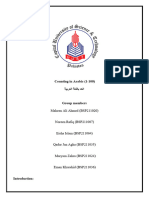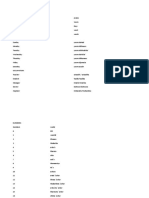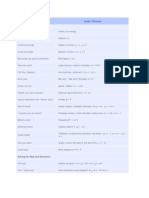Number Ten Wa-Wa - And)
Number Ten Wa-Wa - And)
Uploaded by
Ashanti Chloe Kamantigue BautistaCopyright:
Available Formats
Number Ten Wa-Wa - And)
Number Ten Wa-Wa - And)
Uploaded by
Ashanti Chloe Kamantigue BautistaOriginal Title
Copyright
Available Formats
Share this document
Did you find this document useful?
Is this content inappropriate?
Copyright:
Available Formats
Number Ten Wa-Wa - And)
Number Ten Wa-Wa - And)
Uploaded by
Ashanti Chloe Kamantigue BautistaCopyright:
Available Formats
0
sifr ithnan arbaa sitta thamaniya (th in thin) ashra ithna ashar arbaa ashar sitta ashar thamaniya ashar ishrun ithnane wa-ishrun arbaa wa-ishrun sitta wa-ishrun thamaniya wa-ishrun thalathun arbaun khamsun sittun sabun thamanun tisun mi'a mi'at alf Million
wahid thalatha (th as in bath) khamsa saba tisa ahada ashar thalatha ashar khamsa ashar saba ashar tisa ashar wahed wa-ishrun thalatha wa-ishrun khamsa wa-ishrun saba wa-ishrun tisa wa-ishrun wahid wa-thalathun ithnan wa-arbaun thalatha wa-khamsun arba'a wa-sittun khamsa wa-sabun sitta wa-thamanun sab'a wa-tisun alf alfain
2 4 6 8 10 12 14 16 18 20 22 24 26 28 30 40 50 60 70 80 90 100 100000
3 5 7 9 11 13 15 17 19 21 23 25 27 29 31 42 53 64 75 86 97 1000 2000
10000000
Forming numbers in Arabic is quite easy, from 13 to 19 you just place a number before ten for example 13 = three ten, instead of thirteen in English, 17 is seven ten in Arabic. From 21 to 99 you just need to reverse the numbers and add (wabetween the two numbers) 36 would be six wa- thirty instead of thirty six (sitta wathalathun), (wa means and). 0 is sifr in Arabic, from which the word cipher came. For 11 and 12 theyre irregular, so just remember how to write them by now (11 = ehda ashar, 12 = ithna ashar). So in general, numbers standing alone are easy to use, or say. The hard part is that numbers 3 to 10 have a unique rule of agreement with nouns known as polarity: A numeral in masculine gender should agree with a feminine referrer and vice versa (thalathatu awlaad = three boys), boys are masculine plural, so the feminine form of
number 3 should be used (which is thalathatu, and not thalathu which is the masculine form, the u at the end of numbers is used when a number is followed by another word to make an easy jump to the next word) (thalathu banaat = three girls) banaat = girls, which is feminine plural, therefore a masculine form of number 3 should be used (thalathu). That may sound complicated but once you get used to it, it will not be as hard as it seems now, besides most Arab natives make mistakes or simply dont care about matching the gender and the number. If you are looking for a more extensive Arabic course, we recommend Breaking The Arabic Code
Arabic Ordinal Numbers: Ordinal numbers in Arabic are almost like the cardinal numbers, with some exceptions in the numbers from 1 to 10, and a slight difference in numbers from 11 and up. Note that ordinal numbers in Arabic are somehow like adjectives, so they have to take the masculine, or feminine form. Please check the adjectives page for more information.
Arabic Cardinal Numbers Awwal Thani Thaleth Rabe Khaames Sadis Sabe Thamen Tase acher Hady achar Thani achar
First Second Third Fourth Fifth Sixth Seventh Eighth Ninth Tenth Eleventh Twelfth
Oula Thania Thaletha Rabea Khaamesa Sadisa Sabea Thamena Tasea achera Hadiata achar Thania achar
After 10 only the first number takes the feminine, for example 13 th is thaleth achar for masculine, and thalethata achar for feminine, achar stays the same, the first half thaleth which means 3rd takes a in the feminine, and so does the rest of the ordinal number, except ten numbers like 20, 30, 40, 50, they look like cardinal numbers but they add a as a prefix for numbers starting with a consonant, for example: 70 =
sabun, 70th = asabun (for both masculine and feminine), and they add al for ten numbers starting with a vowel, like: 40= arbaun, 40th = alarbaun.
You might also like
- 1 Review (Task 1)Document6 pages1 Review (Task 1)thientruc.teachingNo ratings yet
- Arabic NumbersDocument2 pagesArabic NumbersImoMohd57% (7)
- Focus 4 b2b2 Teachers BookDocument1 pageFocus 4 b2b2 Teachers BookGorokhivskaYevaNo ratings yet
- Class 7Document6 pagesClass 7selef1234No ratings yet
- Arabic Numbers in EnglishDocument2 pagesArabic Numbers in Englishaqilkhan100% (3)
- Useful Arabic PhrasesDocument6 pagesUseful Arabic PhrasesShiv KeskarNo ratings yet
- Arabic Numbers, Cardinal and OrdinalDocument2 pagesArabic Numbers, Cardinal and Ordinalcolorado wilderness100% (2)
- Arabic Report Final - ModifiedDocument8 pagesArabic Report Final - ModifiedEesha IslamNo ratings yet
- Arabic NumbersDocument5 pagesArabic NumbersWajid hussain MemonNo ratings yet
- S2 M1L2 Arabic+Alphabet+AliftoYaa Updated+ (Autosaved)Document46 pagesS2 M1L2 Arabic+Alphabet+AliftoYaa Updated+ (Autosaved)Jeyssa YermoNo ratings yet
- ArabicDocument71 pagesArabicjacobabrahamvalloorNo ratings yet
- Egyptian Arabic Lesson 1Document4 pagesEgyptian Arabic Lesson 1Paul SullivanNo ratings yet
- Counting in ArabicDocument3 pagesCounting in ArabicLú D Melo MeloNo ratings yet
- New Microsoft Word DocumentDocument3 pagesNew Microsoft Word Documentxionati2No ratings yet
- Counting in ArabicDocument7 pagesCounting in ArabicAnas AliNo ratings yet
- Basic Arabic WordsDocument12 pagesBasic Arabic WordssohailjafferyNo ratings yet
- Numbers in ArabicDocument13 pagesNumbers in ArabicFajar IqbalNo ratings yet
- Arabic VocabularyDocument67 pagesArabic VocabularyEngr Waqas AhmadNo ratings yet
- Egyptian Arabic Language Lesson 1Document5 pagesEgyptian Arabic Language Lesson 1Paul SullivanNo ratings yet
- Nahw Let Us Count in Arabic and Get A HeadacheDocument3 pagesNahw Let Us Count in Arabic and Get A Headacheapi-3709915No ratings yet
- Eighty Ninety: Tham Næn Tis ÆnDocument1 pageEighty Ninety: Tham Næn Tis ÆnsameeNo ratings yet
- Arabic 2019Document27 pagesArabic 2019Sujiya KhanNo ratings yet
- Survival Phrases #26 Counting 11 - 100 in Arabic: Lesson NotesDocument9 pagesSurvival Phrases #26 Counting 11 - 100 in Arabic: Lesson NotesXoxyxuzuniNo ratings yet
- Malfooz ThanwiDocument57 pagesMalfooz ThanwiAAJANGDA100% (1)
- Di Manakah Pula Hak Wanita TulenDocument4 pagesDi Manakah Pula Hak Wanita TulenMohamed PauziNo ratings yet
- Chiffres ArabesDocument43 pagesChiffres ArabesKastali FatimaNo ratings yet
- Day Three: Numerals 20-MillionDocument11 pagesDay Three: Numerals 20-MillionSudhir RavipudiNo ratings yet
- Egyptian Arabic - Desert Sky NetDocument127 pagesEgyptian Arabic - Desert Sky NetD.Elder100% (1)
- Arab NumbersDocument5 pagesArab Numbersten_seikenNo ratings yet
- NumeralsDocument4 pagesNumeralsNatika NagyNo ratings yet
- How To Pray NamazDocument25 pagesHow To Pray NamazAtmrezaNo ratings yet
- Hindi NumbersDocument5 pagesHindi NumberssrajaprojectsNo ratings yet
- Arabic PhrasesDocument6 pagesArabic Phrasespaolocparrera100% (2)
- Arabic NumbersDocument13 pagesArabic NumbersShermin Arshad100% (1)
- Arabic LearningDocument5 pagesArabic LearningAsim Aly100% (1)
- Arabic To Communicate With PatientsDocument19 pagesArabic To Communicate With PatientsDK Aquino GomezNo ratings yet
- Arabic Phrases PDFDocument3 pagesArabic Phrases PDFAbu Dawood100% (6)
- IntroductionDocument13 pagesIntroductionfatima razzaqNo ratings yet
- Sacred Text 3Document1 pageSacred Text 3stjeanmylesNo ratings yet
- Basic Words and Phrases in ArabicDocument6 pagesBasic Words and Phrases in ArabicL.a.ZumárragaNo ratings yet
- LebaneseDocument34 pagesLebanesecionela_2100% (2)
- Arabic FrasesDocument6 pagesArabic Frasesxionati2No ratings yet
- Arabic QuickDocument32 pagesArabic QuickHerkur kurniNo ratings yet
- Fiqh of DeathDocument4 pagesFiqh of DeathAwais_123No ratings yet
- ArabicDocument39 pagesArabicFa AiNo ratings yet
- Learn Languages With Speak7: Greetings and GoodbyesDocument32 pagesLearn Languages With Speak7: Greetings and GoodbyesazeezzuddinNo ratings yet
- Microsoft Word - Beginners Guide To ArabicDocument4 pagesMicrosoft Word - Beginners Guide To ArabicMustakeem Rafik SatyaNo ratings yet
- Beginner S1 #24 Doing Math in Iran: Lesson NotesDocument10 pagesBeginner S1 #24 Doing Math in Iran: Lesson NotesAury MejiaNo ratings yet
- Useful Arabic Phrases and WordsDocument10 pagesUseful Arabic Phrases and WordsEdmond GonzalesNo ratings yet
- Berber Srbi Srba PDFDocument153 pagesBerber Srbi Srba PDFCp6_Cp6ckuNo ratings yet
- Barelvy AqeedahDocument85 pagesBarelvy Aqeedahjavd123100% (2)
- Arabic PhrasesDocument3 pagesArabic PhrasesMarcus Amadeus von Bergen0% (1)
- Blessings of SalahDocument58 pagesBlessings of SalahAli Asghar AhmadNo ratings yet
- Let's Talk Arabic: 1,001 Real-life Phrases and Idioms -- The Way People Really SpeakFrom EverandLet's Talk Arabic: 1,001 Real-life Phrases and Idioms -- The Way People Really SpeakNo ratings yet
- Survival Arabic: How to communicate without fuss or fear INSTANTLY! (Arabic Phrasebook & Dictionary) Completely Revised and Expanded with New Manga IllustrationsFrom EverandSurvival Arabic: How to communicate without fuss or fear INSTANTLY! (Arabic Phrasebook & Dictionary) Completely Revised and Expanded with New Manga IllustrationsRating: 5 out of 5 stars5/5 (2)
- Survival Arabic Phrasebook & Dictionary: How to Communicate Without Fuss or Fear Instantly! (Completely Revised and Expanded with New Manga Illustrations)From EverandSurvival Arabic Phrasebook & Dictionary: How to Communicate Without Fuss or Fear Instantly! (Completely Revised and Expanded with New Manga Illustrations)Rating: 5 out of 5 stars5/5 (1)
- Arabic You Already Know: Shared Words, Loan Words and CognatesFrom EverandArabic You Already Know: Shared Words, Loan Words and CognatesNo ratings yet
- Simple Present Tense - Three FormsDocument2 pagesSimple Present Tense - Three FormsRizka AmaliaNo ratings yet
- How To Form An Open-Ended Interrogative SentenceDocument4 pagesHow To Form An Open-Ended Interrogative Sentence남BeaNo ratings yet
- ConditionalsDocument3 pagesConditionalsEric PochonNo ratings yet
- A1.2 Unit 4 Present Simple 3rd Person - Frequency AdverbsDocument10 pagesA1.2 Unit 4 Present Simple 3rd Person - Frequency AdverbsSergio VelandiaNo ratings yet
- Linguistic Analysis of Chris S Speech PDFDocument4 pagesLinguistic Analysis of Chris S Speech PDFMaría M MalakNo ratings yet
- Conditionals Exercises 1 PDFDocument1 pageConditionals Exercises 1 PDFฉัตรอรุณ ตันสุนNo ratings yet
- Agree (Verb) : English Phrases: The Key To Correct EnglishDocument3 pagesAgree (Verb) : English Phrases: The Key To Correct EnglishCris ElaNo ratings yet
- The Case of Judeo-Spanish Interrogative Pronoun Loké (Lo Qué) - Ana StulicDocument3 pagesThe Case of Judeo-Spanish Interrogative Pronoun Loké (Lo Qué) - Ana StulicCurso De Ladino Djudeo-EspanyolNo ratings yet
- Expressions of Opinions and BeliefsDocument2 pagesExpressions of Opinions and BeliefsAmir AbidNo ratings yet
- Shakespeare GrammarDocument6 pagesShakespeare Grammardjelif100% (1)
- Descriptive Grammar Vs Prescriptive GramDocument3 pagesDescriptive Grammar Vs Prescriptive GramSophia Catalan100% (1)
- AdverbiosDocument19 pagesAdverbiosaldair12No ratings yet
- Stack The Deck Writing Program SOSDocument4 pagesStack The Deck Writing Program SOSOlga KardashNo ratings yet
- Sol3e Preint U9 Short Test 1b (Homework)Document1 pageSol3e Preint U9 Short Test 1b (Homework)arpikyanaNo ratings yet
- Jadi disuruh membuat kalimat menggunakan present participle dan past participle masing masing 3 dan bentuk kalimatnya itu bukan berbentuk present continus jadi present dan past participle dijadiin kata sifat untuk kata bendaDocument3 pagesJadi disuruh membuat kalimat menggunakan present participle dan past participle masing masing 3 dan bentuk kalimatnya itu bukan berbentuk present continus jadi present dan past participle dijadiin kata sifat untuk kata bendaYunia ayu PuspitaNo ratings yet
- Introducing English Syntax A Basic GuideDocument387 pagesIntroducing English Syntax A Basic GuideramboNo ratings yet
- Arabic Hebrew Greek Study SheetDocument75 pagesArabic Hebrew Greek Study SheetAnonymous 7QjNuvoCpINo ratings yet
- Name: - Irregular Verbs List - SpanishDocument6 pagesName: - Irregular Verbs List - SpanishDegetaGamerNo ratings yet
- DAY 03 - UNIT 1 (WHO ARE YOU) (Lesson 3&4)Document41 pagesDAY 03 - UNIT 1 (WHO ARE YOU) (Lesson 3&4)Thắng VũNo ratings yet
- What Are Articles?: After The Long Day, The Cup of Tea Tasted Particularly GoodDocument3 pagesWhat Are Articles?: After The Long Day, The Cup of Tea Tasted Particularly GoodkiranNo ratings yet
- A Stylistic Approach To The God of Small Things PDFDocument75 pagesA Stylistic Approach To The God of Small Things PDFJenif Roque100% (1)
- AdjectivesDocument38 pagesAdjectivesFOM YESCH100% (3)
- Active Passive Voice (Notes)Document12 pagesActive Passive Voice (Notes)khushbooNo ratings yet
- Gramatika Engleskog JezikaDocument3 pagesGramatika Engleskog JezikaducamorisNo ratings yet
- PunctuationDocument68 pagesPunctuationKathalina VasquezNo ratings yet
- Unit 3 - Reference and Sense-NEWDocument28 pagesUnit 3 - Reference and Sense-NEWHuynh Thi Cam NhungNo ratings yet
- English PracticeDocument8 pagesEnglish PracticeHero GarkaNo ratings yet

























































































